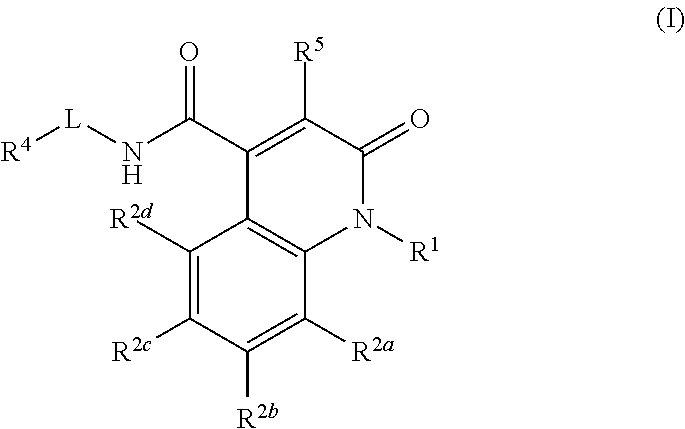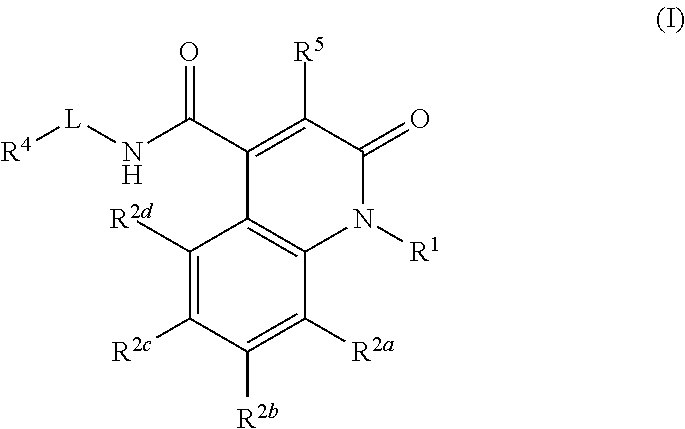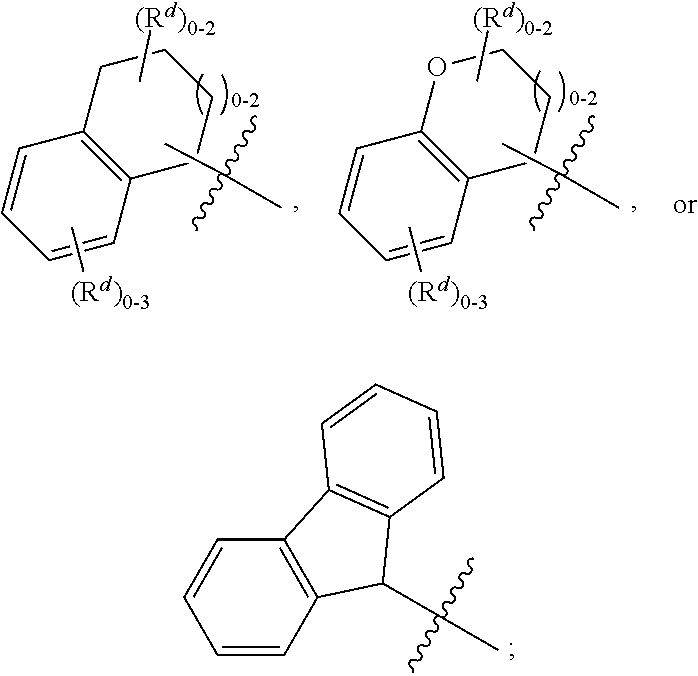Quinolinone carboxamide inhibitors of endothelial lipase
a technology of endothelial lipase and carboxamide, which is applied in the direction of drug composition, biocide, metabolic disorder, etc., can solve the problem that cardiovascular disease is a major health risk
- Summary
- Abstract
- Description
- Claims
- Application Information
AI Technical Summary
Benefits of technology
Problems solved by technology
Method used
Image
Examples
example 1a
3-hydroxy-1-methyl-2-oxo-1,2-dihydroquinoline-4-carboxylic acid
[0448]
[0449]Ethyl 3-hydroxy-1-methyl-2-oxo-1,2-dihydroquinoline-4-carboxylate (Intermediate 16, 2.10 g, 8.49 mmol) was stirred in NaOH (50 mL, 50 mmol). The mixture was heated at reflux for 2 h. The residue was allowed to cool and acidified with 1N HCl (ca. 50 mL) dropwise through an additional funnel at 0° C. The precipitate was collected by filtration, rinsed with H2O (2×), and dried to give Example 1A (1.80 g, 8.21 mmol, 97% yield) as a white solid.
example 1
[0450]
[0451]A solution of Example 1A (83 mg, 0.38 mmol) and Intermediate 1 (65 mg, 0.27 mmol) were stirred at rt in DMF (1.5 mL). HOBT (77 mg, 0.50 mmol) and EDC (96 mg, 0.50 mmol) were added followed by the addition of triethylamine (0.215 mL, 1.54 mmol). The mixture was stirred at rt overnight. EtOAc was added and the organic phase was washed with H2O, brine, and concentrated. The residue was dissolved in MeOH and purified by reverse phase HPLC (MeOH / H2O / TFA). Example 1 (22 mg, 0.054 mmol, 20% yield) was isolated as a white solid after drying. LC-MS (ESI) m / z 438.8 (M+H), RT=2.22 min (Method B). Orthogonal HPLC RT=10.88 min, 100% (Method A); RT=9.64 min, 98.9% (Method B). 1H NMR (400 MHz, acetone) δ ppm 7.76 (1H, d, J=7.6 Hz), 7.60-7.73 (1H, m), 7.43-7.59 (4H, m), 7.23-7.36 (2H, m), 3.82 (3H, s), 3.53 (2H, q, J=6.6 Hz), 2.77-2.93 (2H, m), 1.91-2.05 (2H, m).
example 2
N-(3-(2,4-Dichlorophenyl)propyl)-3-hydroxy-1-methyl-2-oxo-1,2-dihydroquinoline-4-carboxamide
[0452]
[0453]To a solution of Example 1A (67 mg, 0.31 mmol) was added thionyl chloride (66.9 μL, 0.92 mmol). The reaction mixture was stirred at 80° C. for 2 h, allowed to cool and was concentrated under reduced pressure to give the crude 3-hydroxy-1-methyl-2-oxo-1,2-dihydroquinoline-4-carbonyl chloride (62 mg, 0.26 mmol, 85% yield). 3-Hydroxy-1-methyl-2-oxo-1,2-dihydroquinoline-4-carbonyl chloride (0.020 g, 0.084 mmol) was stirred in CH2Cl2 (1 mL). Intermediate 2 (0.025 g, 0.084 mmol) was added, followed by the addition of triethylamine (0.035 mL, 0.25 mmol) at 0° C. The mixture was stirred at rt for 1 h, then concentrated under reduced pressure. The residue was dissolved in MeOH and purified by HPLC (MeOH / H2O / TFA). Example 2 (3 mg, 7.40 μmol, 8.8% yield) was isolated as a white solid after drying. LC-MS (ESI) m / z=404.9 (M+H), RT=2.10 min (Method B). Orthogonal RT=9.999 min, 100% (Method A); ...
PUM
| Property | Measurement | Unit |
|---|---|---|
| Rg | aaaaa | aaaaa |
| Rg | aaaaa | aaaaa |
| temperatures | aaaaa | aaaaa |
Abstract
Description
Claims
Application Information
 Login to View More
Login to View More - R&D
- Intellectual Property
- Life Sciences
- Materials
- Tech Scout
- Unparalleled Data Quality
- Higher Quality Content
- 60% Fewer Hallucinations
Browse by: Latest US Patents, China's latest patents, Technical Efficacy Thesaurus, Application Domain, Technology Topic, Popular Technical Reports.
© 2025 PatSnap. All rights reserved.Legal|Privacy policy|Modern Slavery Act Transparency Statement|Sitemap|About US| Contact US: help@patsnap.com



